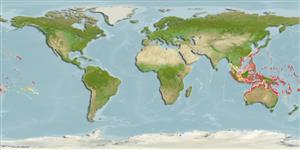>
Eupercaria/misc (Various families in series Eupercaria) >
Lethrinidae (Emperors or scavengers) > Lethrininae
Etymology: Lethrinus: Greek, lethrinia, a fish pertaining to genus Pagellus.
More on author: Seale.
Environment: milieu / climate zone / depth range / distribution range
Ökologie
seewasser riff-verbunden; standorttreu; tiefenbereich 2 - 30 m (Ref. 2295), usually 2 - 18 m (Ref. 37816). Tropical; 31°N - 32°S, 96°E - 134°W
Pacific Ocean: Indonesia and Philippines, north to southern Japan, south to Australia, east to the Tuamoto Islands. Has most frequently been named Lethrinus mahsena.
Length at first maturity / Size / Gewicht / Alter
Maturity: Lm ?, range 28 - ? cm
Max length : 50.0 cm TL Männchen/unbestimmt; (Ref. 48635); common length : 32.5 cm TL Männchen/unbestimmt; (Ref. 2295); max. veröff. Alter: 24 Jahre (Ref. 2290)
Rückenflossenstacheln (insgesamt): 10; Rückenflossenweichstrahlen (insgesamt): 9; Afterflossenstacheln 3; Afterflossenweichstrahlen: 8.
Inhabits seagrass beds and sandy areas of lagoons and outer reef slopes. Found singly or in schools. Feeds mainly on crustaceans, mollusks, and fish. Marketed fresh (Ref. 9775).
Life cycle and mating behavior
Geschlechtsreife | Fortpflanzung | Ablaichen | Eier | Fecundity | Larven
Gonochorism is inferred for this species as sizes of males and females overlapped and male gonad morphology is typical of secondarily derived testes (Ref. 103751). Juvenile hermaphroditism is exhibited by this species (Ref. 35994).
Carpenter, K.E. and G.R. Allen, 1989. FAO Species Catalogue. Vol. 9. Emperor fishes and large-eye breams of the world (family Lethrinidae). An annotated and illustrated catalogue of lethrinid species known to date. FAO Fish. Synop. 125(9):118 p. Rome: FAO. (Ref. 2295)
IUCN Rote Liste Status (Ref. 130435)
Bedrohung für Menschen
Harmless
Nutzung durch Menschen
Fischereien: weniger kommerziell; Sportfisch: ja
Mehr Information
ReferenzenAquakulturAquakultur ProfilZuchtlinienGenetikElectrophoresesVererbbarkeitKrankheitenVerarbeitungNutrientsMass conversion
PartnerBilderStamps, Coins Misc.LauteCiguateraGeschwindigkeitSchwimmstilKiemenoberflächeOtolithsGehirngrößeSehfähigkeit
Tools
Zusatzinformationen
Download XML
Internet Quellen
Estimates based on models
Preferred temperature (Ref.
123201): 25.1 - 29.3, mean 28.6 °C (based on 2744 cells).
Phylogenetic diversity index (Ref.
82804): PD
50 = 0.5000 [Uniqueness, from 0.5 = low to 2.0 = high].
Bayesian length-weight: a=0.01585 (0.01028 - 0.02443), b=3.00 (2.88 - 3.12), in cm total length, based on LWR estimates for this species & Genus-body shape (Ref.
93245).
Trophic level (Ref.
69278): 3.8 ±0.0 se; based on diet studies.
Widerstandsfähigkeit (Ref.
120179): mittel, Verdopplung der Population dauert 1,4 - 4,4 Jahre. (K=0.29-0.31; tm=3.7-5; tmax=24).
Prior r = 0.49, 95% CL = 0.33 - 0.74, Based on 1 stock assessment.
Fishing Vulnerability (Ref.
59153): Moderate vulnerability (35 of 100).
Nutrients (Ref.
124155): Calcium = 44.1 [31.1, 63.0] mg/100g; Iron = 0.829 [0.557, 1.158] mg/100g; Protein = 20.3 [17.7, 22.5] %; Omega3 = 0.123 [0.088, 0.169] g/100g; Selenium = 37.1 [20.8, 58.2] μg/100g; VitaminA = 30.9 [6.9, 161.8] μg/100g; Zinc = 2.07 [1.59, 2.64] mg/100g (wet weight);
